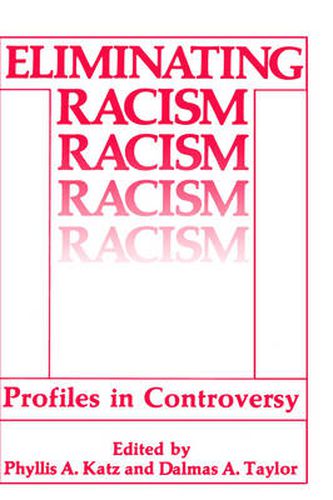Readings Newsletter
Become a Readings Member to make your shopping experience even easier.
Sign in or sign up for free!
You’re not far away from qualifying for FREE standard shipping within Australia
You’ve qualified for FREE standard shipping within Australia
The cart is loading…






This title is printed to order. This book may have been self-published. If so, we cannot guarantee the quality of the content. In the main most books will have gone through the editing process however some may not. We therefore suggest that you be aware of this before ordering this book. If in doubt check either the author or publisher’s details as we are unable to accept any returns unless they are faulty. Please contact us if you have any questions.
The chapters presented here provide the reader with an awareness of the divergent views of what constitutes racism and frameworks for reducing it. This book points out that the dialogue and research on this subject since the mid-1970s have yielded increased contro versy over the theories, foundation, and continued existence of racism. Ironically, what we viewed in the 1954Brown decision and the Civil Rights Act of 1964as the beginning of the end of racism turned out to be the beginning of confusion over the course of action to ensure societal acceptance of political mandates. Hence, the title of this book captures the essence of the emotional core of any forum for examining racism, past and present. One of the most controversial forums has been that ofeducation, beginning with the D.S. Supreme Court’s 1954ruling in Brown v. Board oi Education. Behind every event that has spawned controversy is a profile in courage. It was not a simple decision for the players in the scenario of the Brown v. Board oi Education case to step forward and present themselves as evidence of discrimination. Blackparents supported by black organizations viewed this legal action as a chance for equal opportunity. Yet, the 1950s were a time when black communities were pained by the thought that bigotry and institutional racism would forever stand in the way of their achieving equality.
$9.00 standard shipping within Australia
FREE standard shipping within Australia for orders over $100.00
Express & International shipping calculated at checkout
This title is printed to order. This book may have been self-published. If so, we cannot guarantee the quality of the content. In the main most books will have gone through the editing process however some may not. We therefore suggest that you be aware of this before ordering this book. If in doubt check either the author or publisher’s details as we are unable to accept any returns unless they are faulty. Please contact us if you have any questions.
The chapters presented here provide the reader with an awareness of the divergent views of what constitutes racism and frameworks for reducing it. This book points out that the dialogue and research on this subject since the mid-1970s have yielded increased contro versy over the theories, foundation, and continued existence of racism. Ironically, what we viewed in the 1954Brown decision and the Civil Rights Act of 1964as the beginning of the end of racism turned out to be the beginning of confusion over the course of action to ensure societal acceptance of political mandates. Hence, the title of this book captures the essence of the emotional core of any forum for examining racism, past and present. One of the most controversial forums has been that ofeducation, beginning with the D.S. Supreme Court’s 1954ruling in Brown v. Board oi Education. Behind every event that has spawned controversy is a profile in courage. It was not a simple decision for the players in the scenario of the Brown v. Board oi Education case to step forward and present themselves as evidence of discrimination. Blackparents supported by black organizations viewed this legal action as a chance for equal opportunity. Yet, the 1950s were a time when black communities were pained by the thought that bigotry and institutional racism would forever stand in the way of their achieving equality.